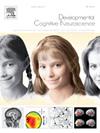Resting state EEG classifies developmental status in three-year-old children
IF 4.9
2区 医学
Q1 NEUROSCIENCES
引用次数: 0
Abstract
Monitoring cognitive development in early childhood enables detection of problems for timely intervention. However, currently recommended methods require lengthy evaluations of task performance, and are resource intense. Here we examined whether 3 minutes of resting-state EEG (rs-EEG) recorded in 70 33–40-month-old children using a 14-channel portable EEG device in low-resource households could classify performance on five domains of developmental outcomes (cognition, receptive language, expressive language, fine motor and gross motor coordination) as measured by the Bayley’s Scale of Infant and Toddler Development, 3rd Edition (BSID-III). Applying supervised learning models to a combination of spectral features and novel time-domain features derived from EEG data, we predicted BSID-III domain scores with moderate accuracy (AUCs ranging from 0.70 to 0.84 and F1-scores ranging from 0.58 to 0.76). While spectral frequencies significantly correlated with cognitive and language domain scores, time-domain features describing amplitude variability were more significantly correlated and contributed more substantially to model outcomes. Model performance was reliable even with a subset of 4 channels. Overall, this study provides a first demonstration that rs-EEG from low electrode configuration devices can serve as a quick and reliable indicator of cognitive developmental outcomes and aid in identifying those requiring support during early childhood.
静息状态脑电图对三岁儿童的发育状态进行分类
监测儿童早期的认知发展可以发现问题并及时进行干预。但是,目前建议的方法需要对任务执行情况进行冗长的评价,而且资源紧张。本文研究了70名低资源家庭中使用14通道便携式脑电图仪记录的3 分钟静息状态脑电图(rs-EEG)是否可以根据Bayley婴幼儿发展量表第三版(BSID-III)对5个发展结果领域(认知、接受性语言、表达性语言、精细运动和大运动协调)的表现进行分类。将监督学习模型应用于从EEG数据中获得的频谱特征和新时域特征的组合,我们以中等精度预测了BSID-III域得分(auc范围为0.70至0.84,f1得分范围为0.58至0.76)。虽然频谱频率与认知和语言域得分显著相关,但描述幅度可变性的时域特征相关性更显著,对模型结果的贡献更大。即使使用4个通道的子集,模型性能也是可靠的。总的来说,这项研究首次证明了低电极配置装置的rs-EEG可以作为认知发展结果的快速可靠指标,并有助于识别儿童早期需要支持的人。
本文章由计算机程序翻译,如有差异,请以英文原文为准。
求助全文
约1分钟内获得全文
求助全文
来源期刊

Developmental Cognitive Neuroscience
NEUROSCIENCES-
CiteScore
7.60
自引率
10.60%
发文量
124
审稿时长
6-12 weeks
期刊介绍:
The journal publishes theoretical and research papers on cognitive brain development, from infancy through childhood and adolescence and into adulthood. It covers neurocognitive development and neurocognitive processing in both typical and atypical development, including social and affective aspects. Appropriate methodologies for the journal include, but are not limited to, functional neuroimaging (fMRI and MEG), electrophysiology (EEG and ERP), NIRS and transcranial magnetic stimulation, as well as other basic neuroscience approaches using cellular and animal models that directly address cognitive brain development, patient studies, case studies, post-mortem studies and pharmacological studies.
 求助内容:
求助内容: 应助结果提醒方式:
应助结果提醒方式:


